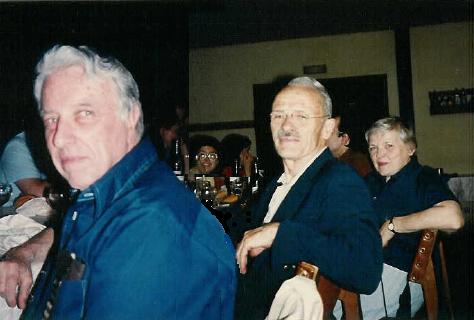Stories
The brain mechanisms of aggression
Motivational systems of social behavior
International Society for Research on Aggression
Behavior Genetics Association Ethics Committee
The World Wide
Runners Club
for Peace
United Nations University for Peace
Charlie Robbins, barefoot runner
* * *
My appreciation for behavior genetics goes back to my college days at Columbia around 1958 when I was lucky to get into a small discussion group with a Russian immigré scientist named Theodosius Dobzhansky. Later, when I started working with the genetic variables in my laboratory rats, I went to a meeting of the Behavior Genetics Association in 1978 and got to know one of Dobzhansky's students, Anita Pruzan, and appreciate further the genius of her mentor.
At the next meeting, which took place in Middletown, I met others at meetings of the Behavior Generics Association who, like me, were concerned with the misuse of genetic explanations to justify racism, class power, sexism and the culture of war and violence. In fact, as I would point out in my Journal of Peace Research article on the history of the Seville Statement on Violence, genetic arguments are the most often mis-used to justify the status quo when it is challenged. We established an ethics committee and, as I was doing at that time for the International Society for Research on Aggression, I agreed to be the secretary for a commitee of correspondance.
After many exchanges of correspondances, we set up a workshop which was a great success at the next BGA meeting which took place in Chicago in 1980. Here is how I described it in a letter to Doug Wahlsten, a committee member who could not be present.:
The workshop was distinguished by the level of participation. I think there were only about 120 people at the entire conference and we had 89 at the first part of the workshop. We took a short break after an hour of discussion and when we returned, we still had about 70 of them. And 30 people spoke altogether - a third of the audience. The quality of the remarks was terrific. Several students helped break the ice and get things going, including students of Jerry Hirsch who, by the way, have joined the committee. He must be a fine teacher to have students like them. Once it warmed up, there were memorable commentaries - lengthy and thoughtful - from Elving Anderson, Benson Ginsburg, Jerry Hirsch, Lee Ehrman, and John Paul Scott among others. Lee Willerman defended the status quo in IQ research against vigorous criticism from others including Ehrman and Hirsch... I gave the last word, effectively, to John Paul Scott who made an impassioned plea that we put science to constructive rather than destructive work."
Several years later, John Paul Scott and Benson Ginsburg, along with Ginsburg's student, Bonnie Frank Carter, would play major roles with me in the Seville Statement on Violence.

Ben Ginsburg, John Paul Scott and Scott's wife, Mary Vesta at Seville
When I came to fear that my work in behavioral genetics could be mis-used for new military weapons, I stopped all behavior genetics research in my lab and stopped going to meetings of the Behavior Genetics Association after Fort Collins in 1982. The last I heard was from Doug Wahlsten in 1983 that he had become the corresponding secretary, and they were planning for the 1984 BGA meetings.
 |
Stages
1986-1992
Fall of Soviet Empire
1992-1997
UNESCO Culture of Peace Programme